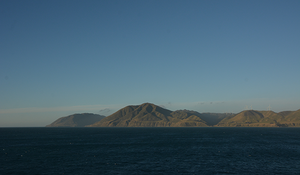
Photo Credit: Christopher Stephens, New Zealand Geographic Board
On either side of the Cook Strait are two headlands with apparently Māori names, but it is possible that neither is correct. Both were recorded by Cook, but neither have the spelling that he applied.
On the 31 January 1770, Cook spoke to Topaa (Topea), an older Māori man, on Motuara Island in Queen Charlotte Sound / Tōtaranui. Cook questioned Topaa about local geography. Topaa described the lands to the north and south. Cook noted in his diary, that Topaa pointed across the strait to ‘Teirawhitte’ and duly labelled the southwest headland of the North Island ‘Cape Teirawhitte’.
A few days later, Cook noted in his journal they passed another headland, ‘call'd by the Natives Koamaroo’.
Both of these names were then subject to a variety of misspellings, but continued to be used on maps and in navigational aids.
When the Honorary Geographic Board of New Zealand was established in 1924, it tried to standardise the spelling of place names. It decided the eastern cape would be Cape Terawhiti, as that name was in common usage. The Board noted, however, that the correct spelling was Tarawhiti (under the influence of Elsdon Best), while others argued it should be ‘Te Rawhiti’ or ‘Te Ra Whiti’. The western cape would be Cape Koamaru, rather than Koamoru as it was often spelt in the newspapers.
Why is it so hard to ascertain the spelling or meaning of these two place names? In addition to the challenges of researching Māori place names (i.e. traditions being passed down orally, the loss of knowledge due to colonisation and other factors), this area of New Zealand has had a reasonably fluid population, with many conquests and migrations occurring. Names may have been picked up by later arrivals or, these names may not be the Māori names for these features. Some have pointed out that Terawhiti may simply mean ‘the east’ and was not attached to that particular headland. One scholar argues that Koamaru is a ‘hybrid placename’ and the original name is Operuahua.
References
- NZ Gazetteer - Cape Terawhiti
- NZ Gazetteer - Cape Koamaru
- James Cook, ‘31 January 1770’, South Seas: Voyaging and Cross-Cultural Encounters in the Pacific (1760-1800)
- James Cook, ‘6 February 1770’, South Seas: Voyaging and Cross-Cultural Encounters in the Pacific (1760-1800)
- NZGB Correspondence, 15 December 1951, Vol 27, p. 140; Hare Hongi, ‘Maori Place-names’, Evening Post, 15 May 1934, p. 4
- Huia Pacey, ‘Please adjust your bearings…’, in Ian D. Clark, Luise Hercus, Laura Kostansk (eds), Indigenous and Minority Placenames: Australian and International Perspectives, ANU Press, Canberra, 2014, p. 357